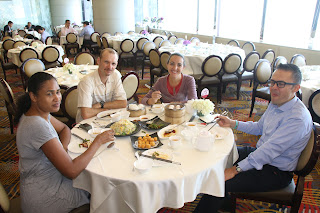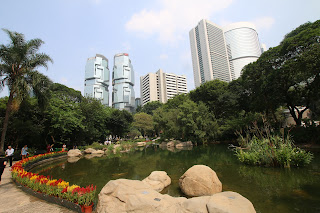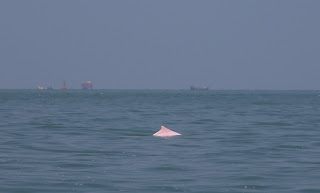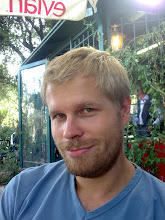One of the "must things" to do when visiting Hong Kong is to head over to Macau, which is only a 1-hour ferry ride away. Most people just go for a day trip, but since we had a week in total in HK, we decided to spend the night there (also, we figured Raphaelle and Olivier would appreciate a bit of privacy...). So, bright 'n early on Wednesday morning, we got up, headed to HK central, from where we got on the ferry to Macau.
 Macau, like Hong Kong was a European colony until the end of the 20th century. Portugal seeded Macau back to China in 1999 (making it the last European colony in Asia, actually). These days Macau enjoys similar autonomy as Hong Kong (that is, China handles defence and foreign policy, and the rest is handled by Macau). Thanks to its status as world capital of gambling, Macau boasts the world's highest GDP per capita by purchasing power parity.
Macau, like Hong Kong was a European colony until the end of the 20th century. Portugal seeded Macau back to China in 1999 (making it the last European colony in Asia, actually). These days Macau enjoys similar autonomy as Hong Kong (that is, China handles defence and foreign policy, and the rest is handled by Macau). Thanks to its status as world capital of gambling, Macau boasts the world's highest GDP per capita by purchasing power parity.
After arriving in the harbor, we jumped on the shuttle bus which took us to our hotel (which, considering the 60 Euros we paid for the room, was a rather luxurious affair!), located not too far away from the city center. After dropping off our bags at our room, we headed off to explore Macau. We started off by navigating the chaotic streets of Macau up to the Fortaleza do Monte. At first glance, the prosperity of Macau wasn't obvious, it seemed like a very busy, rather unremarkable Chinese town. (similar to Hong Kong, yet also clearly different - both as far as architecture and atmosphere is concerned).
Fortaleza do Monte is quite a well-preserved military installation, overlooking Macau from its hilltop, dating back to 1617. This was the military center of Macau during colonial towns - these days it houses a museum dedicated to Macau's history. We didn't visit the museum, but did checkout the impressive views over Macau from up there. This was also where Macau was governed during the early days of the colony.
We then walked down into the focal point of the historical center of Macau; the ruins of Saint-Paul's church. It is one of the most famous landmarks of historic Macau - but actually only the facade remains. Behind the church, there is a Chinese temple - a symbol of religious harmony during colonial times I suppose?
We had a bit of a walk around the historic center - which is extremely touristy, it has to be said. There are plenty of shops that cater for tourists' need (the vast majority being Chinese these days, there was more dried fish on sale than traditional Portuguese pastries). We found a cozy-looking and not too touristy looking restaurant on a side street where we had lunch (I had a small hamburger, and a durian milkshake).
We continued our exploration by checking out the Protestant cemetery, a surprisingly interesting place. Macau was of course primarily Catholic, being a former Portuguese colony, but there were plenty of Americans and Brits, who were consequently buried in the Protestant cemetery (well, apart from the Catholics, of course). A quite peaceful place, all in all, and it was kind of morbidly interesting to trace the destinies of colonists here in Macau based on what was written on their tombstones... There was an interesting, well-groomed park next to the cemetery, which seemed to be overran by elderly Macau men playing mahjong and other card games.
We then started walking back to our hotel, stopping my at Lou Lim Lok garden, quite a nice little garden (apparently based on Suzhou style gardens from mainland China). We still came to the conclusion that we prefer Japanese gardens over Chinese ones, though.
Before dinner, we enjoyed the hotel swimming pool for a bit - gotta stay in shape, right? For dinner, we'd booked a Portuguese restaurant. After some miscommunication with the taxi driver, we eventually ended up at the restaurant. We had a rather nice meal at the restaurant - nice to have a bit of European wine as well (it's been a while since the last time!). I was a bit disappointed by the fact that the cuisine seemed purely Portuguese (I was hoping for some sort of fusion between Chinese and Portuguese food).
What to do at night in Macau then? Easy question to answer, go check out the casinos! So we jumped on a local bus, and crossed the bridge from the mainland to Taipa island, where the new casinos are located (Macau town center is actually located on the Chinese mainland). The first impression for us was one of "wow". They don't do things halfheartedly in Macau, these monster casinos must surely be as impressive as anything Las Vegas has to offer (can't say for sure as I've never been...).
We started at the most famous of them all, the Venetian. The place is, as expected, ridiculous. It's the 7th biggest building by area in the world, and the biggest one in Asia (it measures a ridiculous 980,000 square meters). It's also the biggest casino in the world. And it's not only a casino, the shopping facilities are just ridiculous (I'm pretty sure there are more shops in this place than all of Helsinki...). The theme here is all about Venice - the shopping floors are basically remodelled after Venice, with gondolas, a fake blue sky and canals all there to keep us entertained. Kind of reminded us of Marina Sands in Singapore. (unsurprising as it's operated by the same group, Las Vegas Sands).
We also checked out the nearby Parisian resort, which was nearly as ridiculous. The Parisian hotel has been developed by Las Vegas Sands as well. We were less impressed by the Parisian than by the Venitian, for some reason, in spite of the half-scale Eiffel Tower located next to the casino (I wanted to go up to the top to do a bit of night photography, but that was forbidden unfortunately due to the ongoing typhoon alert).
Well impressed, and happy to have resisted to the temptation to gamble (not that hard actually since the minimum bet was about 100 Euros...), we took the bus back to the hotel, and collapsed in our beds, exhausted after a very fulfilling yet tiring day...
The next day, we started off by a session at the hotel pool before continuing our exploration of Macau. We took a local bus to Taipa island again, the plan being to explore Taipa village, which is supposed to be the best-preserved bit of "old Macau" (kind of surprising as it's located not to far from the sprawling Casino developments of the Cotai strip). It was indeed a rather pleasant place to stroll around. The place was definitely less touristy than the colonial center in Macau, while still retaining a distinctly colonial feel.
We found another Portuguese restaurant, where we decided to stop for lunch. We had duck and suckling pig, yummie...
Before heading back to Macau, we decided to check out Cotai strip by daylight. It's definitely more impressive by night, when the ridiculously over-the-top constructions are lit up, but those buildings still looked damned big by daytime, too! Still, I would definitely recommend going by night (obviously, there are also more people in the casinos then).
Before catching the ferry back to HK, we decided to check out another fortress on Guia hill, as it's located just next to our hotel. Again, the views from up there were very impressive. We struggled a bit to find our hotel, as we ended up on the wrong side of the hill, but we found it eventually. And then, alas, it was time to head back to HK.
All in all, a very interesting little excursion. Macau definitely merits the detour from Hong Kong, as it's quite an interesting little place with its own unique character and history.
 Macau, like Hong Kong was a European colony until the end of the 20th century. Portugal seeded Macau back to China in 1999 (making it the last European colony in Asia, actually). These days Macau enjoys similar autonomy as Hong Kong (that is, China handles defence and foreign policy, and the rest is handled by Macau). Thanks to its status as world capital of gambling, Macau boasts the world's highest GDP per capita by purchasing power parity.
Macau, like Hong Kong was a European colony until the end of the 20th century. Portugal seeded Macau back to China in 1999 (making it the last European colony in Asia, actually). These days Macau enjoys similar autonomy as Hong Kong (that is, China handles defence and foreign policy, and the rest is handled by Macau). Thanks to its status as world capital of gambling, Macau boasts the world's highest GDP per capita by purchasing power parity.After arriving in the harbor, we jumped on the shuttle bus which took us to our hotel (which, considering the 60 Euros we paid for the room, was a rather luxurious affair!), located not too far away from the city center. After dropping off our bags at our room, we headed off to explore Macau. We started off by navigating the chaotic streets of Macau up to the Fortaleza do Monte. At first glance, the prosperity of Macau wasn't obvious, it seemed like a very busy, rather unremarkable Chinese town. (similar to Hong Kong, yet also clearly different - both as far as architecture and atmosphere is concerned).
Fortaleza do Monte is quite a well-preserved military installation, overlooking Macau from its hilltop, dating back to 1617. This was the military center of Macau during colonial towns - these days it houses a museum dedicated to Macau's history. We didn't visit the museum, but did checkout the impressive views over Macau from up there. This was also where Macau was governed during the early days of the colony.
We then walked down into the focal point of the historical center of Macau; the ruins of Saint-Paul's church. It is one of the most famous landmarks of historic Macau - but actually only the facade remains. Behind the church, there is a Chinese temple - a symbol of religious harmony during colonial times I suppose?
We had a bit of a walk around the historic center - which is extremely touristy, it has to be said. There are plenty of shops that cater for tourists' need (the vast majority being Chinese these days, there was more dried fish on sale than traditional Portuguese pastries). We found a cozy-looking and not too touristy looking restaurant on a side street where we had lunch (I had a small hamburger, and a durian milkshake).
We continued our exploration by checking out the Protestant cemetery, a surprisingly interesting place. Macau was of course primarily Catholic, being a former Portuguese colony, but there were plenty of Americans and Brits, who were consequently buried in the Protestant cemetery (well, apart from the Catholics, of course). A quite peaceful place, all in all, and it was kind of morbidly interesting to trace the destinies of colonists here in Macau based on what was written on their tombstones... There was an interesting, well-groomed park next to the cemetery, which seemed to be overran by elderly Macau men playing mahjong and other card games.
We then started walking back to our hotel, stopping my at Lou Lim Lok garden, quite a nice little garden (apparently based on Suzhou style gardens from mainland China). We still came to the conclusion that we prefer Japanese gardens over Chinese ones, though.
Before dinner, we enjoyed the hotel swimming pool for a bit - gotta stay in shape, right? For dinner, we'd booked a Portuguese restaurant. After some miscommunication with the taxi driver, we eventually ended up at the restaurant. We had a rather nice meal at the restaurant - nice to have a bit of European wine as well (it's been a while since the last time!). I was a bit disappointed by the fact that the cuisine seemed purely Portuguese (I was hoping for some sort of fusion between Chinese and Portuguese food).
What to do at night in Macau then? Easy question to answer, go check out the casinos! So we jumped on a local bus, and crossed the bridge from the mainland to Taipa island, where the new casinos are located (Macau town center is actually located on the Chinese mainland). The first impression for us was one of "wow". They don't do things halfheartedly in Macau, these monster casinos must surely be as impressive as anything Las Vegas has to offer (can't say for sure as I've never been...).
We started at the most famous of them all, the Venetian. The place is, as expected, ridiculous. It's the 7th biggest building by area in the world, and the biggest one in Asia (it measures a ridiculous 980,000 square meters). It's also the biggest casino in the world. And it's not only a casino, the shopping facilities are just ridiculous (I'm pretty sure there are more shops in this place than all of Helsinki...). The theme here is all about Venice - the shopping floors are basically remodelled after Venice, with gondolas, a fake blue sky and canals all there to keep us entertained. Kind of reminded us of Marina Sands in Singapore. (unsurprising as it's operated by the same group, Las Vegas Sands).
We also checked out the nearby Parisian resort, which was nearly as ridiculous. The Parisian hotel has been developed by Las Vegas Sands as well. We were less impressed by the Parisian than by the Venitian, for some reason, in spite of the half-scale Eiffel Tower located next to the casino (I wanted to go up to the top to do a bit of night photography, but that was forbidden unfortunately due to the ongoing typhoon alert).
Well impressed, and happy to have resisted to the temptation to gamble (not that hard actually since the minimum bet was about 100 Euros...), we took the bus back to the hotel, and collapsed in our beds, exhausted after a very fulfilling yet tiring day...
The next day, we started off by a session at the hotel pool before continuing our exploration of Macau. We took a local bus to Taipa island again, the plan being to explore Taipa village, which is supposed to be the best-preserved bit of "old Macau" (kind of surprising as it's located not to far from the sprawling Casino developments of the Cotai strip). It was indeed a rather pleasant place to stroll around. The place was definitely less touristy than the colonial center in Macau, while still retaining a distinctly colonial feel.
We found another Portuguese restaurant, where we decided to stop for lunch. We had duck and suckling pig, yummie...
Before heading back to Macau, we decided to check out Cotai strip by daylight. It's definitely more impressive by night, when the ridiculously over-the-top constructions are lit up, but those buildings still looked damned big by daytime, too! Still, I would definitely recommend going by night (obviously, there are also more people in the casinos then).
Before catching the ferry back to HK, we decided to check out another fortress on Guia hill, as it's located just next to our hotel. Again, the views from up there were very impressive. We struggled a bit to find our hotel, as we ended up on the wrong side of the hill, but we found it eventually. And then, alas, it was time to head back to HK.
All in all, a very interesting little excursion. Macau definitely merits the detour from Hong Kong, as it's quite an interesting little place with its own unique character and history.





















































